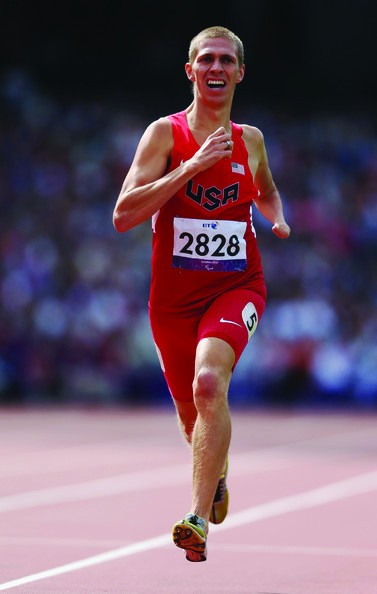It’s Hammer Time

Courtesy Photo / Zimbio.com Former GVSU runner Chris Hammer at the 2012 London Paraolympic.
Sep 12, 2012
Former Grand Valley State University standout Chris Hammer was born with what some people may call a disability, but that hasn’t stopped him from achieving success throughout his life. Hammer recently competed in the London Paralympics where he finished in ninth place in the 1500-meter event with a time of 4 minutes and 1.76 seconds, which was ten seconds behind the podium. He finished 10th in the marathon and ran a seasonal-best 2:50.30. In the 800 meters, Hammer was not able to advance out of his heat and finished with a time of 2:04.68.
Hammer was a part of the T46 classification at the Paralympics. T46 is defined as a “single above-elbow amputation, single below-elbow amputation, or athletes who have normal function in both legs but impairment in the trunk and/or arms.” Hammer was born without a left hand, but was hesitant at first to take part in the Paralympics.
“One of the coaches from the Paralympic team approached me at a track meet when I was racing for Grand Valley,” he said. “I blew it off at first. I didn’t really think it was a legitimate thing, but after talking to teammates and people I saw it was an opportunity to represent your country and to travel places. It’s something you can’t pass up. Don’t think of it as you’re racing because of a disability, but see it as an opportunity. I never ever saw myself as being remotely disabled. That’s how I was raised and I don’t think I am in that kind of position.”
Another challenge facing Hammer was his training. The varying race distances made it nearly impossible for Hammer to train for all three events. “It was a challenge training Chris because he is running the 800 meters, the 1500 meters, and the marathon,” said GVSU assistant coach Nick Polk, who trained Chris. “We worked on a lot of speed work to try to get him in the right position to run fast, but longer runs to prepare for the marathon as well. It was difficult to train for all three, but we did it the best we could.”
Hammer is a graduate student enrolled at Eastern Washington University and also is involved in an internship and is also a graduate assistant. Since Hammer was training in Washington, Polk had to resort to constant communication with Hammer in order to coach him through his training. “We’d talk over the phone, email and online through a running log and I can keep track what he does every day,” Polk said. “I’d give him a workout and he’d tell me how it went. He’s a very strong minded and really coachable athlete. Often times, he’s getting up at 5:30 or 6 a.m. to get his workouts in.
Hammer was a four-time All-American during his time at GVSU, where he finished in the top seven of the 3,000 meter steeplechase every year at the NCAA Division II Outdoor Track and Field Championships. “He was one of our best runners in the history of our program,” head coach Jerry Baltes said. “He was doing great things when he was here with us. He was always a committed hard worker, and very disciplined. He never saw the lack of his left hand as being a disability. He did what he could to the best of his abilities.”
Hammer was able to transfer some of the success he had at GVSU to his training for these Paralympics. However, not everything he learned at GVSU could prepare him for competing on one of the biggest stages.
“Grand Valley taught me about the basic principles of running from the coaching staff and gaining race experience,” he said. “Going up to the NCAAs and being a part of Grand Valley with all of our championship experience racing at national meets, gave me some experience racing at a big meet setting, but nothing can really prepare you for 80,000 people yelling and cheering for you. The overall experience was awesome. Representing your country in international competition is one of the biggest privileges you could have.”
[email protected]





















